Menu
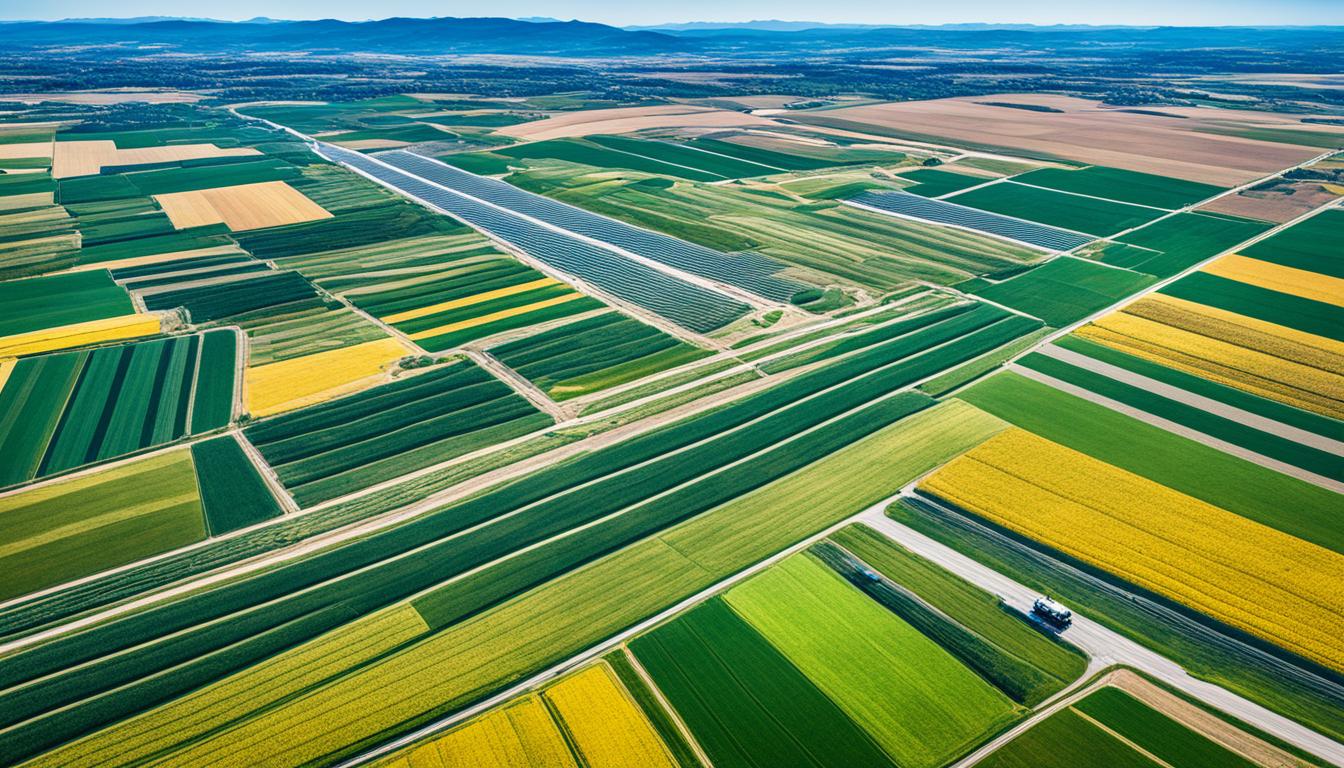
Did you know an agricultural company can handle more than 300 grain types? They use over 300 silos and over 200,000 ways to transport. This creates thousands of possible ways things can move. This shows why it’s so important to really check how agricultural supply chains work. Also, it’s key to look at the logistics of farming businesses and how they connect with rural areas.
Managing this big network well is super important. Research shows that using digital twin tech can make a big difference. Some companies have seen crop payments to farmers go up by 5 percent. But, sadly, not many companies can turn pilot tech projects into something big. This shows the big challenge and chance to make supply chains better with new tech and smart plans.
Understanding the agricultural supply chain means looking closely at many things. This includes SWOT and PESTLE checks. They help find out about strong points, weak points, chances, and dangers. They also look at how political, economic, social, tech, legal, and environmental issues impact the business. Now, making sure our farming practices are eco-friendly and make good money is a top goal for companies around the world.
The global “Agricultural Supply Chain Service Market” report gives us good info. It helps us see the roles of different places, effects on the economy, and more. This detailed view is important for making farm industries work well everywhere. Let’s look closer at each part of agricultural supply chains. We’ll see their parts, the issues they face, and the new tech and ideas that will shape their future.
Agricultural supply chains are key to the agrarian economy. They move products from farms to people smoothly. These chains are complex. They need careful analysis to make every step better. This goes from when the goods are made to when they reach the market.
The agricultural supply chain has many stages. Each one is important for the end product’s quality and availability. Works like production, storage, processing, and retailing are all vital. Using analytics helps us see how these stages connect. It gives us hints on improving the product flow, markets, and tech.
Efficient supply chains cut down on product waste and boost sales. They make tracking products to their start point easier. This helps to keep them safe and top quality. By working together, everyone in the chain can use better methods and tech. This makes the chain stronger. Top sellers like Walmart and Carrefour have high standards for suppliers. They expect them to meet rules like EUREP-GAP and BRC2. This pushes the whole chain to do better.
Farm supply chain analytics are really helpful. They give us key info on value chains. Even small farmers who sell locally can benefit. They face challenges like not knowing enough about markets. Or not having much power in deals. Better supply chain analysis leads to more teamwork. This lowers arguments and lifts the whole chain’s success.
An efficient supply chain helps everyone make more money. This is true for both small farmers and big agriculture businesses. It shows us that working well together is key. It leads to ongoing success and profit in farming.
Reference: The United States Agency for International Development defines a value chain as the “full range of activities required to bring a product or service from conception to end use, encompassing all market channels available to all firms.”
The agricultural supply chain is a big network with many important steps. Each step helps the food get from the farm to your table smoothly. By knowing about each stage, we see how everything in the network is connected together.
Farming starts things off in the supply chain. Farmers grow a variety of crops, with some managing over 300 types. When these crops are ready, they are harvested. Then, they are moved to storage places.
Some companies have a lot of these storage areas. This system helps in the next supply chain stages. It shows how everything is closely connected.

After harvesting, the crops are processed into foods we eat at processing plants. This step is really important, especially for sugar. A decade’s worth of data helps in planning how to collect and distribute crops. This data helps in reaching consumer safety, health, and environment goals.
Getting the processed goods to the end consumer is the last big step. It’s very complex. For example, a single company might handle over 200,000 ways to transport goods.
About half of manufacturing companies are using digital tools more. This helps make the process smoother. But, only a few have fully embraced these digital solutions.
By working on these aspects, the agricultural supply chain can better reach buyers in the West. It also helps in meeting their changing needs over time. Masters these key areas is vital in a market that is always changing.
It’s crucial to understand the hurdles in agriculture’s supply chain to make it work better. A lot of obstacles stop goods from flowing smoothly from the farm to the shopper.
The chain’s split nature makes it hard for goods to move easily. Many people are involved, like those who sell seeds, farmers, processors, sellers, and buyers. They all rely on each other, which makes keeping things smooth very tough. The loss of soil and land, which costs up to $40 billion yearly, makes this worse. This setup leads to waste and unexpected problems that are hard to solve.
This chain faces many unpredictable events that make planning hard. Bad weather, which is getting worse, changes how much food we can produce. Crops might not grow well, leading to hunger for 811 million people in 2021. Also, when diseases spread, both people and animals could get sick. This causes a lack of workers and products. Global fights can also stop the food moving, adding to these problems.
The market’s always changing, and this affects how much money people make and if they can keep up. Prices of important things might suddenly go up; for example, fertilisers’ prices jumped by 30% in the first half of 2022. Shipping costs in the U.S. have gone up by 50% since 2020. Tight ports, expensive energy, and fights between countries make moving things harder. A shortage of fresh produce in the UK forced limits on buying things like tomatoes and cucumbers, showing the impact of these changes.
Looking at these issues through careful study and assessment can help make the supply chain more manageable and strong.
| Challenge | Impact | Example |
|---|---|---|
| Fragmented Networks | Inefficiencies and unpredictable outcomes | $40 billion annual losses due to land degradation |
| Operational Uncertainty | Inconsistent yields and disrupted supply chains | 811 million people faced hunger in 2021 |
| Market Volatility | Price fluctuations affecting profitability | Fertiliser prices increased by 110% over 1.5 years |
Technology is changing agriculture fast. It’s bringing new solutions to make farming better and more transparent. This bit looks at how things like digital twins, data analysis, predictive models, and blockchain are changing how farms work.
Digital twins and simulations are new and exciting. They make virtual copies of real farm stuff. Farmers use these to plan and test decisions before doing them for real. This means they can guess what will happen, use resources better, and look after their plants more efficiently. And, when something like bad weather shows up, they’re ready.
Data analysis and predictive models are big deals in farming. They look at things like how much harvest to expect, if the soil is healthy, and how to fight pests. By using lots of data and smart math, farmers can do things smarter. They can plant at the best time, waste less, and run their business more smoothly.
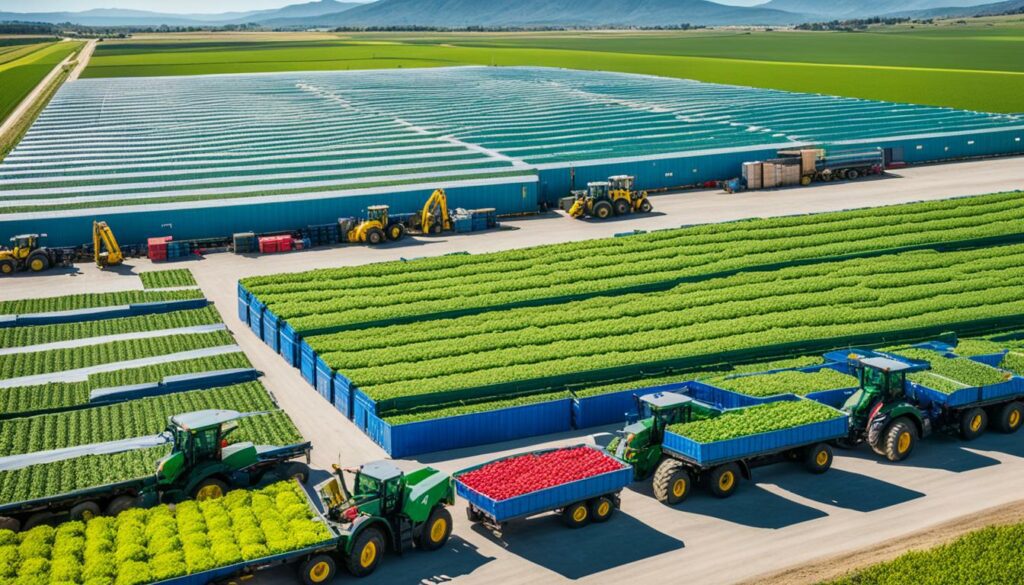
Now, blockchain isn’t just for money; it’s helping track farm products too. Its special way of storing data means we can follow food from where it’s grown to where it’s eaten. This helps deal with not enough people to do paperwork, stops mistakes, and keeps information safe. Also, it tells us exactly how food was made and packed, which is good for the planet.
Together, AI, robots, and smart tools with old-fashioned farming are changing everything. These new ways are making farms more effective, kind to the earth, and strong against problems.
Today, understanding the agricultural supply chain deeply is more key than ever. Methods like SWOT and PESTLE help us understand it better. We look at the rural production network through these analyses and study market trends.
SWOT analysis looks at the strengths and weaknesses of agricultural chains. It’s important to identify strong points like many types of crops and lots of storage space. For instance, a leading company has a variety of grains, numerous silos, and vast transportation options.
PESTLE explores the big picture with political and environmental issues considered. For example, President Biden issued a key order about agricultural supply chains in 2021. The USDA’s follow-up report guides how to make supply chains stronger, smarter, and more resilient.
Value chain analysis helps make the supply chain more efficient. A training program in Jaipur shows how to use this method effectively. It proves that improving seeds, managing harvests better, and developing markets can boost incomes and productivity.
Looking at examples from various countries shows us the needs and possible improvements in agriculture. For instance, a detailed analysis of the sugar industry’s data unveiled many ways to improve crop planning and collection. This kind of study can benefit numerous sectors beyond just agriculture.
Knowing the market size and its growth is crucial. Data indicates that many agriculture companies are trying out digital innovations. But only a few are able to move past the trial stage. This shows the importance of studying the market to make meaningful steps.
Evaluating the agricultural sector this way helps us spot trends and issues. It makes sure we’re prepared to meet the needs of modern agricultural supply chains. This comprehensive method keeps us informed and ready to act in the best interest of all.
The agricultural supply chain is like a puzzle with many pieces that fit together perfectly. It includes farmers, manufacturers, technology providers, and agribusinesses. Each group has a crucial part to play. By looking at how they work together, we can really understand the inner workings of this complex system. This exploration is key in making the agricultural supply chain work well and reviewing how farm products move around.
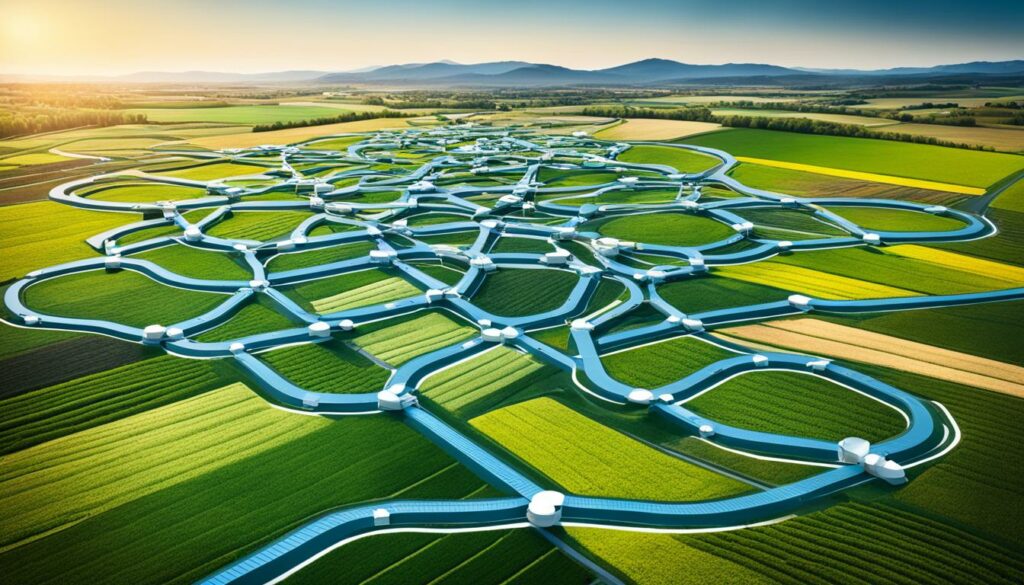
Manufacturers are essential in making sure we have the right tools to work on farms, like seeds and machinery. They bring new ideas to life, making farming more productive and kind to the Earth. Technology providers are also key. They are making the supply chain smarter with tools like digital twins and data analysis. But, many manufacturers are still at the early stages of using these new digital tools.
Farmers are at the heart of everything. How they farm affects how much and what quality of crops we get. Agribusinesses help get the crops from the field to the market. They are using more and more digital methods to run things better. For example, using digital twins has meant more money for some farmers and better timing for collecting crops for most.
Working together, all these groups make the market better for each other. They create chances for growth and keep farming sustainable.
Examining the agriculture supply chain uncovers huge impacts of regional differences. It affects markets and how things work in different places. Regions have their unique challenges and chances, like weather, local customs, and trading policies.
In North America, the agriculture supply chain is driven by tech and big farms. There’s great infrastructure for easy moving of goods. Yet, trade deals among the US, Canada, and Mexico can shake things up. Tariffs and agreements can help or hurt the business, changing prices and exports.
Europe focuses on green farming and following strict rules. The Common Agricultural Policy (CAP) ensures farmers get help and encourages eco-friendly farming. But, water issues hit countries in the south, while the north enjoys good transport. The chain is complicated yet lacks unity, needing new ideas and cooperation.
In Asia-Pacific, farming mixes old ways with newer trends. China shines with a big farming sector. From 2010 to 2019, its farm trading grew from US$121.96 billion to US$228.427 billion. How farming varies from hi-tech in cities to traditional in the countryside impacts the chain. Climate and water supply are key, affecting how well farms do and the quality of what they produce.
| Region | Key Factors | Challenges | Opportunities |
|---|---|---|---|
| North America | Technological advancement, Infrastructure | Trade policies, Market volatility | Efficient distribution, Export potential |
| Europe | Regulatory compliance, Sustainability | Fragmentation, Water scarcity | Eco-friendly practices, Robust logistics |
| Asia-Pacific | Diversified practices, Climatic conditions | Water distribution, Modernisation | High-output production, Market expansion |
Thinking about how crucial sustainability is in agriculture, it’s clear we need eco-friendly methods. These are key for the growth of sustainable farming. They help tackle global challenges like climate change and the need to protect our soil and secure our food.
The world loses up to $40 billion each year from soil loss. This is a big problem needing urgent solutions. As the population grows, we must also produce more food, about 20-30% more by 2050. Sustainable farming is our path to achieving these goals.
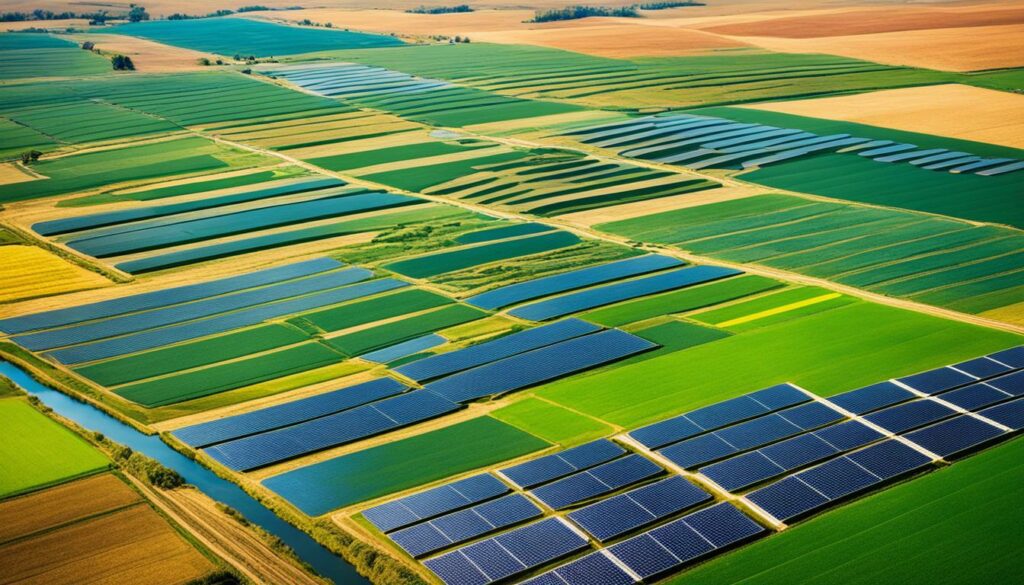
Advancing to smart farming, like precision agriculture, is vital. It uses data to improve our farming practices. Devices and sensors help us use resources wisely. They also cut down on harm to our environment. This way, we can make sure our crops get the right amount of water, fertilizers, and no harmful bugs. So, our food grows better and cleaner.
Drone technology is also making a big impact. It keeps an eye on our crops for signs of any health issues. Drones then apply exactly the right amount of nutrients and bug killers, reducing waste. AI helps us farm smarter by predicting the weather, finding the best time to plant, and spotting diseases early. These new tools help our farms grow in a way that’s good for our planet.
But, we still face challenges, like high fertilizer prices and shipping problems. Technology helps here too. It makes our farming more stable, able to overcome any obstacles. This means we’ll keep getting food, no matter what.
Examples like Thailand show us that working together can make farming more sustainable. When everyone involved in farming joins forces, it leads to better use of resources and less waste. Such efforts also help protect nature and ensure our food supply will last.
In the end, making agriculture green is vital for our planet’s health and saving the diverse life in it. This balanced approach makes farming strong against climate troubles. It secures our food and keeps our economies running smoothly.
Looking after agricultural products after harvest is vital. It helps keep their quality and makes them last longer. This is very important because the world needs more food, and we should decrease the food we waste. New ways of storing and checking the quality of products are key. They make the farm-to-table journey better, earning more money for farmers everywhere.
Storage methods have come a long way. We now have systems that control the environment to keep things fresh. Cold storage is a good example. It stops food from going bad by keeping the right temperature and humidity. This way, products last longer, even after they’re harvested.
In some countries, the sun is used to dry food. This is great for farmers with small amounts of produce. It is cheap and helps food stay edible longer. These methods are a big deal for areas without much tech or good roads. They make it possible for more farmers to keep their food in a better condition.
Checking that food is still good is crucial. Food can vary a lot, making it hard to set standards. To protect quality, strict checks and measures are necessary. They make sure that what we eat is up to standard before it gets to us.
Putting food in good packing with the right storage helps too. It keeps food safe and fresh for longer. This way, people who grow food can make more money. Whether it is how we keep things cold or dry stuff in the sun, good storage is key. These ways help food keep its quality and value.
“In developing countries, improving access to postharvest tools and technologies can effectively mitigate food losses and increase profitability for producers.”
Using the best tools and ways to look after food can help solve food security issues. It makes the whole system work better. Making smart plans with tools like the Support Vector Machine can also cut down food waste. This means making choices that are better for everyone.
Looking at agricultural supply chain analysis in action opens our eyes. Key studies show us what works across different farm economies. This means we can learn a lot about helping farmers and businesses work better.
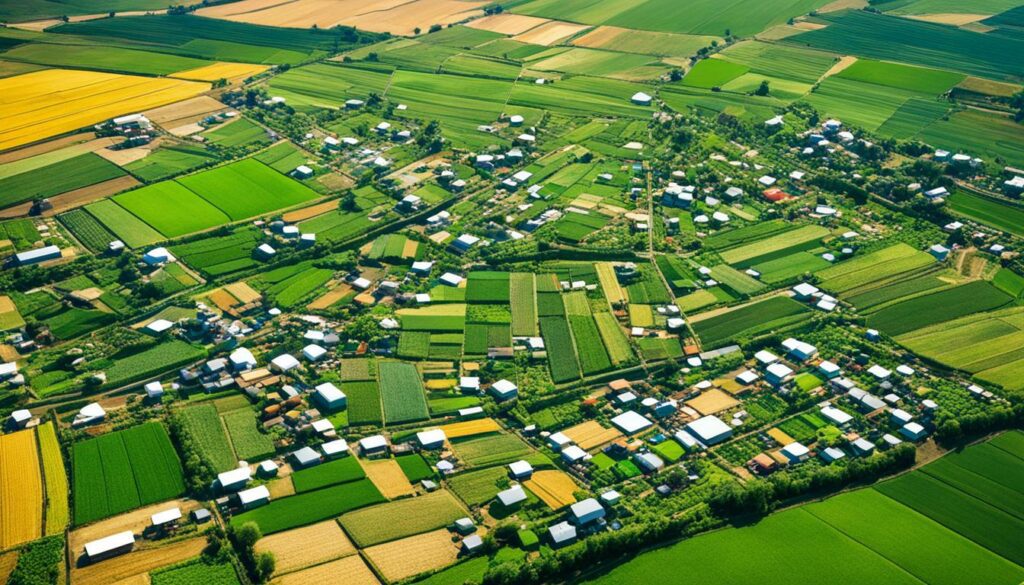
Rwanda’s work on its dairy chain is a great success story. Thanks to help from the International Fund for Agricultural Development (IFAD), the dairy sector has grown a lot. They improved how milk is collected, the factories that process it, and how it’s sold. Now, Rwanda can meet more of its own milk needs.
This move is big news for Rwanda, as it aims to be more self-reliant like India wants to be with its milk in the next ten years.
Guatemala has improved its cardamom farming with agricultural supply chain analysis. Even though they had many hurdles, they made good changes. They worked on making their crops better and getting them to market easier. This way of working, seen also in China’s agriculture, shows us the power of smart analysis in making things better locally.
As we look forward, technology will change how agricultural supply chains work. These changes will make farming more efficient, sustainable, and profitable.
Automation and AI will change how we analyze farming supply chains. AI technology will allow for very precise farming methods. For example, it can accurately predict the weather, find the best times to plant, and spot diseases early. This helps farms produce more with less waste.
Robots and other automated machines will also start doing more tasks. They will plant, harvest, and sort crops. This will make farming operations run smoother.
More people will start selling their food directly to customers through the internet. This trend is a big step for the future of farming. It helps farmers and farming groups sell without going through middlemen. This means better relationships with customers and simpler supply chains. The online market is already significant, highlighting the increase of digital sales in farming.
By using new technology, farming supply chains will get better. It will streamline processes, boost productivity, and keep agriculture sustainable.
The path of the agricultural supply chain is full of obstacles. Creating strong links and powerful risk plans are key. They ensure the system keeps running well and stays strong.
Working closely with others in the supply chain is very important. It brings benefits such as sharing knowledge and making sure everyone is on the same page. This helps deal with problems from outside, like climate change. For example, strawberry farming in California and lots of land in Chile were hurt by fire and drought.
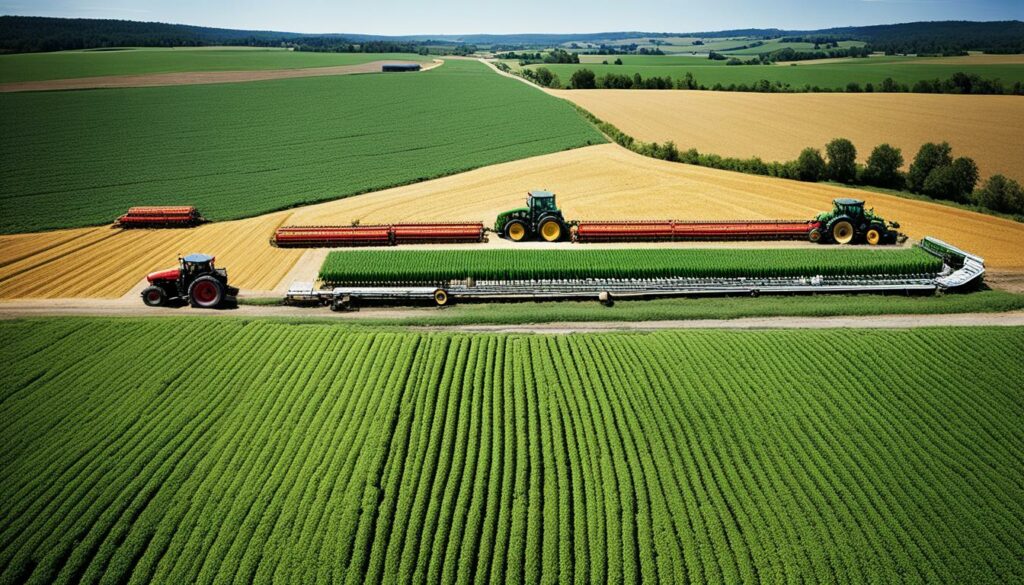
Using technology for better communication is a great step. It shows how working together can help with serious issues, like saving the soil and stopping the loss of plants and animals. These problems cost the world $40 billion each year.
Managing risks in farming means spotting dangers and finding ways to lessen them. With higher transport costs and busy ports, being ready is vital. It helps to keep the system working well.
Here are some ways to do good risk management:
Using these methods means being ready for surprises, like a lack of fresh fruit and veg in the UK. It will help deal with the fact that more food will be needed soon, by 2050. Getting things right now is very important for a smooth and safe future. It also keeps food security around the world. These steps are critical in making the whole supply chain work better.
Government policies and rules hugely impact how our food gets from farm to table. They look at how we trade, our money, and our green and ethical farming rules. This big view helps us see how rules change the farming business.
The way we trade and handle money affects our food chain greatly. For example, President Biden issued an order in 2021 to strengthen our food supplies. The USDA then laid out ways to make things better, like improving information and supporting fairness.
This approach, backed by recent laws, helps make our food supply more stable. It also allows for programs that help during tough times, such as the ARPA.
Laws about the environment and work are key for fair and green farming. They aim to make work safer and help farmers deal with a changing climate. These rules don’t just make things better for workers – they also make the whole system stronger against risks.
The USDA points out that fixing roads and bridges and making things fairer are crucial steps. They build a stronger farming supply system.
In the end, policies around trading, money, the environment, and work safeguard our food chain. They set the stage for making farming more stable, greener, and effective. This all shapes the way policy impacts farming in a big way.
Studying *agricultural supply chain analysis* shows its big economic role. It boosts revenue and creates jobs, helping the economy grow. These are highlights in the world of business.
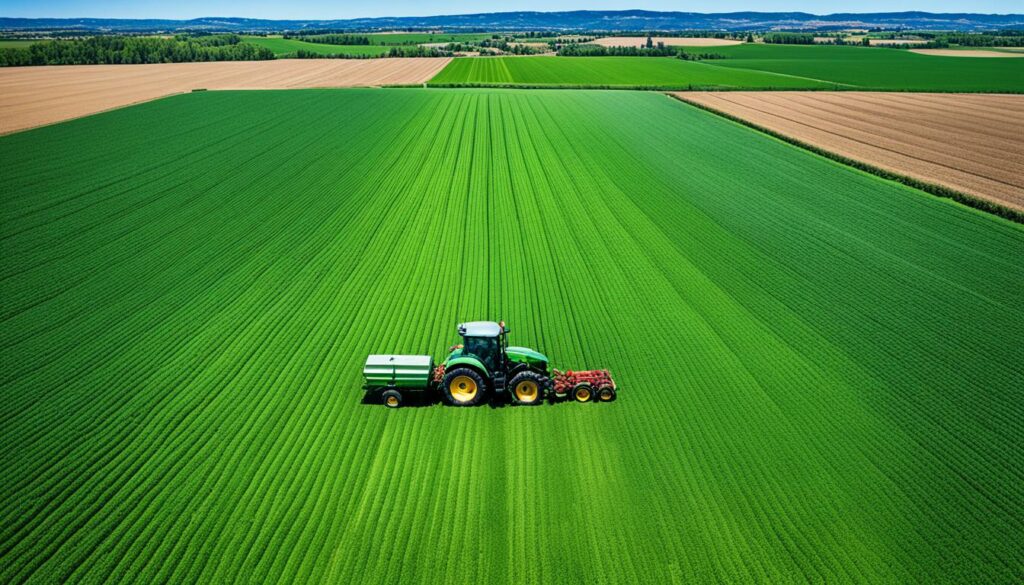
An efficient *agricultural supply chain analysis* helps earn more money in agriculture. It does this by making everything run smoother, wasting less, and making better products. Such steps like those after Executive Order 14017 on “America’s Supply Chains,” have made supply chains stronger. They’ve also made markets smarter.
This spread out the critical supply chain system and made more market intelligence. These actions, said by the USDA, have also helped sell more agriculture products overseas. This has given a direct boost to the money coming in.
Good *agricultural supply chain analysis* also leads to more jobs. With COVID-19 causing troubles in the agriculture world, there were not enough workers. Making supply chains better and stronger opens up more work chances. The USDA wants to make sure there’s fair business and good work conditions.
A well-handled supply chain doesn’t just grow the business. It also makes many new good jobs. This helps people, the community, and local businesses.
| Key Implications | Details |
|---|---|
| Revenue Generation | Boosted by enhanced agricultural exports and reduced wastage. |
| Job Creation | Increased employment in farming, logistics, and related industries. |
| Supply Chain Efficiency | Optimised by the adoption of ICT and data-driven decision-making. |
Agricultural supply chains are complex and need strong ways to work better and greener. In this piece, we explored every part of the chain, from making to sending products out. The agricultural supply chain analysis showed us how new tech and smart use of data can improve farming.
Precision farming has changed how farms work. Things like drones for checking fields and IoT devices and sensors for better planning have boosted harvests. Adding AI to predict the weather and plan planting schedules shows how tech can make big impacts.
Supply chains are very important in farming. Using software to track the farm to the plate, we cut waste and do better overall. Drones spot sick plants early and help use chemicals better. This helps farms be greener and smaller in their waste.
Using data and green ideas in agricultural supply chain analysis promises to make farming better than ever before. Thinking about it, we see that new tech and smart planning are vital for the future of farming. This will make farming more effective, productive, and eco-friendly in the years to come.
The agricultural supply chain has several parts. It starts with production and harvesting, moves to processing and transformation, and ends with transportation and distribution. Each step is vital to ensure we all get our food in time.
Being efficient in the supply chain is key for farms and businesses to do well. It means less waste, better use of resources, and getting food to us on time. This helps keep farms running and our food supply steady.
Challenges come from having many stages, from growing food to selling it. The network can get messy, and not knowing how much we’ll get can be tough. Also, prices can change quickly, making it hard to plan.
Now, we have amazing tools like digital twins and blockchain technology. They help keep supply chains smooth and trace problems. With data, we can predict and fix issues faster, saving money and time.
SWOT and PESTLE look at what helps and what hinders agricultural supply chains. They help us see where we can grow and what risks we face. It’s like having a road map to a better supply chain.
Many people are important, like manufacturers, technology providers, farmers, and agribusinesses. They all add to making supply chains better, from new ideas to getting goods where they need to be.

Making the food chain last is a must. We need to cut down on waste, manage our resources better, and use clean energy. These steps are good for the Earth and for keeping food coming to us.
New ways to keep food fresh are a big deal. Things like controlled-environment storage and better checks on quality help. They make sure the food we get is good and lasts longer.
In Rwanda, dairy farming got a lot better. And in Guatemala, how they make cardamom spice is now more efficient. These changes show how we can fix supply chain problems for the good of everyone.
More machines, smart technology, and buying from farms directly online are growing. These new ways are set to make farming and buying food easier and smarter. They improve how we get and enjoy our meals.
Talking and working together really helps. Also, having smart plans to deal with surprises is a great strategy. With everyone’s help, we can face and beat the hard stuff in farming.
Rules on trade and the environment really guide how we farm and sell food. These laws can make it easier or harder to do business and keep the planet safe. They shape our food’s journey from farm to table.
Good supply chains are a big win for the economy. They make money and jobs in farming and the industries around it. Managing the chain well helps countries grow and keeps food flowing to people.